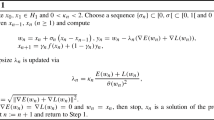Abstract
In this paper our interest is in investigating properties and numerical solutions of Proximal Split feasibility Problems. First, we consider the problem of finding a point which minimizes a convex function \(f\) such that its image under a bounded linear operator \(A\) minimizes another convex function \(g\). Based on an idea introduced in Lopez (Inverse Probl 28:085004, 2012), we propose a split proximal algorithm with a way of selecting the step-sizes such that its implementation does not need any prior information about the operator norm. Because the calculation or at least an estimate of the operator norm \(\Vert A\Vert \) is not an easy task. Secondly, we investigate the case where one of the two involved functions is prox-regular, the novelty of this approach is that the associated proximal mapping is not nonexpansive any longer. Such situation is encountered, for instance, in numerical solution to phase retrieval problem in crystallography, astronomy and inverse scattering Luke (SIAM Rev 44:169–224, 2002) and is therefore of great practical interest.
Similar content being viewed by others
References
Bauschke, H.H., Borwein, J.M.: On projection algorithms for solving convex feasibility problems. SIAM Rev. 38(3), 367–426 (1996)
Bernard, F., Thibault, L.: Prox-regular functions in Hilbert spaces. J. Math. Anal. Appl. 303, 1–14 (2005)
Brézis, H.: Analyse fonctionnelle, théorie et applications. Masson, Paris (1983)
Byrne, Ch.: Iterative oblique projection onto convex sets and the split feasibility problem. Inverse Probl. 18, 441–453 (2002)
Byrne, C.H., Censor, Y., Gibali, A., Reich, S.: Weak and strong convergence of algorithms for the split common null point problem. J. Nonlinear Convex Anal. 13, 759–775 (2012)
Censor, Y., Bortfeld, T., Martin, B., Trofimov, A.: A unified approach for inversion problems in intensity-modulated radiation therapy. Phys. Med. Biol. 51, 2353–2365 (2006)
Chaux, C., Combettes, P.L., Pesquet, J.-C., Wajs, V.R.: A variational formulation for frame-based inverse problems. Inverse Probl. 23, 1495–1518 (2007)
Clarke, Z.F.H., Ledyaev, Y.S., Stern, R.J., Wolenski, P.R.: Nonsmooth Analysis and Control Theory. Springer, New York (1998)
Combettes, P.L., Wajs, V.R.: Signal recovery by proximal forward-backward splitting. Multiscale Model. Simul. 4, 1168–1200 (2005)
Lopez, G., Martin-Marquez, V., Wang, F., Xu, H.K.: Solving the split feasibility problem without prior knowledge of matrix norms. Inverse Probl. 28, 085004 (2012)
Luke, D.R., Burke, J.V., Lyon, R.G.: Optical wavefront reconstruction: theory and numerical methods. SIAM Rev. 44, 169–224 (2002)
Luke, D.R.: Finding best approximation pairs relative to a convex and prox-regular set in Hilbert space. SIAM J. opt. 19(2), 714–729 (2008)
Mallat, S.G.: A Wavelet Tour of Signal Processing, 2nd edn. Academic Press, New York (1999)
Moudafi, A.: Split Monotone Variational Inclusions. J. Optim. Theory Appl. 150(2), 275–283 (2011)
Moudafi, A.: A proximal iterative approach to a nonconvex optimization problem. Nonlinear Anal. Theory Methods Appl. 72, 704–709 (2010)
Opial, Z.: Weak convergence of the sequence of successive approximations for nonexpansive mappings. Bull. Am. Math. Soc. 73, 591–597 (1967)
Poliquin, R.A., Rockafellar, R.T.: Prox-regular functions in variational analysis. Trans. Am. Math. Soc. 348, 1805–1838 (1996)
Polyak, B.T.: Introduction to Optimization. Optimization Software Inc., New York (1987)
Rockafellar, R.T., Wets, R.: Variational Analysis. Springer, Berlin (1988)
Rockafellar, R.T.: Monotone operators and the proximal point algorithm. SIAM J. Control Optim. 14, 877898 (1976)
Xu, H.K.: A variable Krasnosel’skii-Mann algorithm and the multiple-set split feasibility problem. Inverse Probl. 22, 2021–2034 (2006)
Xu, H.-K.: Iterative methods for the split feasibility problem in infinite-dimensional Hilbert spaces, Inverse Probl. 26(10), article 105018 (2010)
Yao, Y., Chen, R., Marino, G., Liou, Y.C.: Applications of fixed point and optimization methods to the multiple-sets split feasibility problem. J. Appl. Math. 2012 Article ID 927530 (2012)
Acknowledgments
The authors would like to thank the anonymous referees for their careful reading, suggestions and pertinent questions which permitted us to improve the first version of this paper.
Author information
Authors and Affiliations
Corresponding author
Rights and permissions
About this article
Cite this article
Moudafi, A., Thakur, B.S. Solving proximal split feasibility problems without prior knowledge of operator norms. Optim Lett 8, 2099–2110 (2014). https://doi.org/10.1007/s11590-013-0708-4
Received:
Accepted:
Published:
Issue Date:
DOI: https://doi.org/10.1007/s11590-013-0708-4




